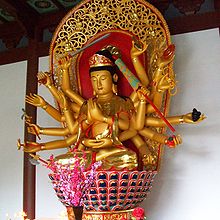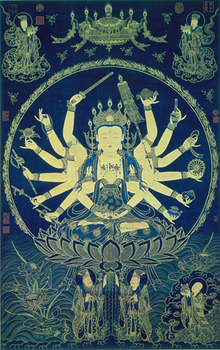- Cundi (Buddhism)
-
Cundī 
Sanskrit: चुन्दी Cundī Chinese: 準提菩薩, 準提佛母
Zhǔntí Púsà, Zhǔntí FómǔJapanese: 准胝観音
Juntei KannonInformation Venerated by: Mahayana, Vajrayana  Chinese gold painting of Cundī. Hanging scroll, gold ink and colors on paper. Ming Dynasty.
Chinese gold painting of Cundī. Hanging scroll, gold ink and colors on paper. Ming Dynasty.
Cundī (Sanskrit: चुन्दी, literally "Extreme Purity") is a buddha or bodhisattva venerated in the Mahāyāna Buddhist schools, with emphasis of her practice in the Esoteric Buddhist schools. She is known as a bhagavati, or "mother of buddhas", and is often equated with the bodhisattva Avalokiteśvara. She may be related to the Hindu goddess Chandi.[1]
Contents
In Buddhist traditions
While Cundī is less well known in the Tibetan Vajrayāna Buddhist community, she is revered in the Chinese and Japanese Buddhist Esoteric sects. In China, she is known as Zhǔntí Púsà (準提菩薩, "Cundī Bodhisattva") or Zhǔntí Fómǔ (準提佛母, "Cundī Buddha-Mother"), while in Japan she is known as Juntei Kannon (准胝観音, "Cundī Avalokitasvara").
In late imperial China, early traditions of Esoteric Buddhism were still thriving in Buddhist communities. Robert Gimello has also observed that in these communities, the esoteric practices of Cundī were extremely popular among both the populace and the elite.[2]
Source texts
The first textual source of Cundī and the Cundī Dhāraṇī is the Kāraṇḍavyūha Sūtra, a sūtra centered around Avalokiteśvara Bodhisattva, and that also introduces the popular mantra oṃ maṇipadme hūṃ.[3] This text is first dated to around the late 4th century CE to the early 5th century CE.[4] Cundī and the Cundī Dhāraṇī are also featured in the Cundī Dhāraṇī Sūtra, which was translated three times from Sanskrit to Chinese in the late 7th century and early 8th century by the Indian esoteric masters Divākara (685 CE), Vajrabodhi (723 CE), and Amoghavajra (8th century).[5]
Cundī Dhāraṇī
According to the Cundī Dhāraṇī Sūtra, the dhāraṇī associated with Cundī is the following:[6]
- namaḥ saptānāṃ samyaksaṃbuddha koṭīnāṃ tadyathā
- oṃ cale cule cundī svāhā
In the sūtra, after the Buddha speaks extensively about the various effects and benefits of reciting the Cundī Dhāraṇī. Many of the effects are purifying and uplifting in nature. For example, after pronouncing the dhāraṇī, the Buddha then says:[7]
If there are bhikṣus, bhikṣuṇīs, upāsakas, or upāsikās who memorize and recite this dhāraṇī 800,000 times, their deadly karma in every place, created over innumerable eons, will be completely annihilated. In every place where they are born or reside, they will always meet buddhas and bodhisattvas. They will always have adequate resources and abilities to do as they wish. In any birth, they will always be able to leave the home life, and will have the ability to maintain the pure precepts of a bodhisattva. They will be born in human or heavenly realms, they will not fall into evil destinies, and they will always be protected by all the heavenly guardians.The dhāraṇī is also closely associated with buddhahood and complete enlightenment (Skt. Anuttarā Samyaksaṃbodhi). At the end of the sūtra, the Buddha closes the teaching by saying:[8]
This great dhāraṇī of Cundī is a great brilliant mantra teaching that is spoken by all buddhas of the past, all buddhas of the future, and all buddhas of the present time. I also now speak it thusly to benefit all sentient beings, causing them to attain Anuttarā Samyaksaṃbodhi. If there are sentient beings with little merit, who lack the roots of goodness, natural ability, and the Factors of Bodhi, if they obtain hearing of this dhāraṇī method, they will quickly realize the attainment of Anuttarā Samyaksaṃbodhi. If there are people who are always able to remember, recite, and maintain this dhāraṇī, they will all obtain immeasurable roots of goodness.Iconography
Cundī is depicted with eighteen arms, all wielding implements that symbolize skillful means of the Dharma. Her eighteen arms also represent the eighteen merits of attaining Buddhahood, as described in an appendix to the Cundī Dhāraṇī Sūtra.[9]
References
- ^ http://cundimantra.weebly.com/
- ^ Jiang, Wu (2008). Enlightenment in Dispute: The Reinvention of Chan Buddhism in Seventeenth-Century China: p. 146
- ^ Studholme, Alexander (2002) The origins of Oṃ maṇipadme hūṃ: a study of the Kāraṇḍavyūha sūtra: p. 175
- ^ Studholme, Alexander (2002) The origins of Oṃ maṇipadme hūṃ: a study of the Kāraṇḍavyūha sūtra: p. 17
- ^ Studholme, Alexander (2002) The origins of Oṃ maṇipadme hūṃ: a study of the Kāraṇḍavyūha sūtra: p. 175
- ^ The Cundī Dhāraṇī Sūtra
- ^ The Cundī Dhāraṇī Sūtra
- ^ The Cundī Dhāraṇī Sūtra
- ^ Maha-Cundi Dharani Sutra
See also
External links
Buddhism Bodhisattvas General list Chinese Vajrayana Other Bhaishajyaraja · Candraprabha · Nagarjuna · Niō · Shantideva · Supratisthitacaritra · Supushpachandra · Suryaprabha · Vasudhara · VisistacaritraChinese Buddhist Pantheon Buddhas: Guānshì Yīn (Avalokiteśvara) | Mañjuśrī (Wénshūshili) | Samantabhadra (Pǔxián) | Ksitigarbha (Dìzàng Wáng) | Mahāsthāmaprāpta (Dàshìzhì) | Vajrapāṇi (Jīngāng Shǒu) | Mílè Púsa (Maitreya) | Cundī (Zhǔntí)Deities:
Guānshì Yīn (Avalokiteśvara) | Mañjuśrī (Wénshūshili) | Samantabhadra (Pǔxián) | Ksitigarbha (Dìzàng Wáng) | Mahāsthāmaprāpta (Dàshìzhì) | Vajrapāṇi (Jīngāng Shǒu) | Mílè Púsa (Maitreya) | Cundī (Zhǔntí)Deities:Four Heavenly Kings (Sì Tiānwáng) | Sangharama (Qíelán) | Skanda (Wéituó) | Yama (Yán Wáng) | Jìgōng |
Sudhana (Shan Cai) | Nagakanya (Long Nü) | Marici (Mólìzhītiān)Mahākāśyapa | Ānanda | Moggallāna | Bodhidharma (Dámó) | An Shigao | Xuánzàng | Fǎxiǎn | Yìjìng | Shàn Dào | Huìguǒ | Emperor Ming | Emperor Wu | Eighteen LuohansCategories:- Bodhisattvas
- Buddhist deities, bodhisattvas, and demons
- Buddhism in China
- Yidams
Wikimedia Foundation. 2010.
